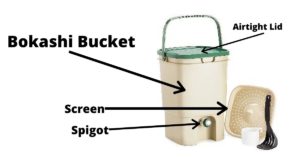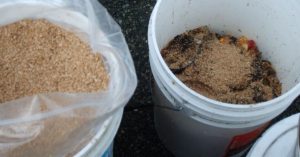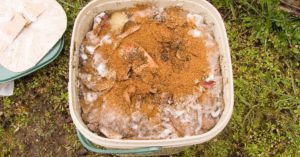Bokashi composting is the newest trend amongst green living enthusiasts. It promises to deliver faster results with less effort. Let’s dive a little deeper into the world of bokashi and see if it is worth the hype.
What is bokashi composting?
Bokashi is a process through which organic waste is converted into a helpful soil addon. However, instead of decomposition, bokashi uses fermentation. In this process, the raw materials special bran are sealed within an airtight container.
The raw materials are then allowed to ferment, and the operator just needs to remove the leachate every other day. The fermentation is finished in as little as two weeks.
This method preserves most of the nutrients as they don’t escape as gas or leach out.
Bokashi composting can process many things like meat and dairy that ordinary composting can’t.
What is the Bokashi mix made of?
Bokashi mix or bran is the most crucial element of the process. It is difficult and inconvenient to ferment organic mix without it.
Bokashi bran is usually a mixture of
- Effective Microorganisms (EM)
- Molasses
- Water
- An organic career with a high carbon percentage
Effective Microorganisms mix is a unique combination of microbes that makes this process possible. It is popularised as “EM” amongst bokashi compost enthusiasts in 120 countries. It is a microbial cocktail comprising of three main types
- Lactobacillus spp. – The bacteria that produce lactic acid
- Rhodopseudomonas spp – It metabolizes lignin and acids, which are present in degrading plant and animal waste
- Saccharomyces spp – This is a species of yeast that plays an essential role in the fermentation
These microbes give the bokashi its signature sour smell. This is by no means a pleasant odor, but it is not as bad as the natural anaerobic process.
How to make bokashi bran at home
A single pack of bokashi bran can cost around $15, making buying it a sour experience. Often people wonder if they can produce this mixture at home?
Well, the good news is, yes, you can make it at home. However, it’s not an easy or quick process. It can take several weeks before you have your first batch of homemade bokashi bran. If you are that patient, here is a process for you
- The first step is to mix two parts of water and one part of water.
- Then, separate the rice and rice water and pour it into a jar
- Cover the jar with the cheesecloth place it in a dark place for a week
- Now add one part of rice wash to 10 parts of the milk. Cover the jar and leave it for two weeks
- After two weeks, your milk should have turned into whey. Remove four tablespoons of it from the jar
- Mix this whey with 12 cups of water and four tablespoons of molasses.
- Now add this liquid to 10 pounds of wheat bran. Mix it properly and remove all the dry patches
- Then seal the mixture into a garbage bag for two weeks
After two weeks, you should have a mixture that has a pickle-ish smell. You can use it as is, but you have to dry it out by spreading it if you wish to store it.
If you need to understand this process better, you can watch this YouTube video.
Bokashi Composting Process/How do you make Bokashi compost?
The bokashi is one of the most uncomplicated composting processes. Once you have added everything into the bucket, it doesn’t require much supervision. The entire process can be divided into three steps.
Step 1: Preparation
The first step is to prepare your bokashi bucket and waste scraps. The best thing about bokashi is that you can add almost any organic matter into it as long as it is cut into small pieces and is not already rotten.
Bokashi Bucket

A bokashi bucket is a plastic container with a tight lid and a spigot at the bottom. It also has a screen to be placed on the bottom to assist in the drainage of the leachate.
Before adding anything to the bucket, please test it out for leaks by pouring some water into it. If it leaks, don’t use it before repairing or else it will fill your compound with an offensive odor.
Filling the bucket
First, place the screen on the bottom of the bucket. Then generously sprinkle bokashi bran on it. After that, add in your food scraps that you have chopped up into small pieces. Press these scraps as tight as possible to remove any air pockets
Add another layer of bran on top of it. Remember to add layers of bran each time you add scraps. Keep repeating these steps until the bucket is full.

That’s it for the preparation. Now close the lid and let the microbes do their work.
Step 2: Fermentation
The bokashi is an anaerobic process which means that it works best in the absence of oxygen. Once you have closed the bucket, make sure that you don’t disturb the microbes by opening it.
During this time, the only thing you have to do is open the tap or spigot once in a few days to drain out the liquid or the bokashi tea.
Let the fermentation in the bucket continue for two weeks. After two weeks, Your bucket should look something like this.

Please note that the compost is not ready to use yet. It still needs to go through one more phase.
Step 3: Burying In the soil
After two weeks of fermentation in the bucket, you need to transfer the food scraps into a fallow patch of soil.
It’s perfectly fine if your food scraps don’t look much processed. The fermentation in the bucket is only the precomposing process. It is not finished yet.
To move the scraps into the soil, you need to dig a hole twice as big as the bucket’s volume. Empty the bucket in the hole and cover it with plenty of soil. Let it remain under soil for two weeks.
When you dug up the hole after two weeks, food scraps should have a different texture. They should be mostly broken down by then. However, it’s normal to have some recognizable fragments of food in the soil.

That’s it; your compost is now ready to use. If you like it more processed, you can wait another week before adding it to your plants.
Bokashi Tea
The liquid that you have been collecting throughout the process is a nutrient-rich garden add-on. However, don’t add it directly to the soil. You should always dilute it with water. A good rule is to mix one part of bokashi liquid with 100 parts of water.
How long does Bokashi take to finish?
It takes around four weeks for the bokashi to finish. Two weeks in the bokashi bucket and two weeks in the soil. After four weeks, the resulting mixture is ready to be used.
Bokashi Compost Vs Regular Compost
| Bokashi | Regular Compost | |
| Process | It is based on the anaerobic process. This means that microbes in bokashi work best without oxygen. That is the reason why we seal the bucket and press the food scraps tightly. | Regular composting is aerobic. That implies that it needs oxygen for optimal functioning. That necessitates regular turning and creating airspaces |
| Time | Bokashi is a fast process. It can deliver the final result in as little as four weeks! | Regular composting, on the other hand, can take upto six months. Even in ideal conditions, it takes 2-3 months. |
| Odor | It has a signature sour smell. People describe it as pickle-ish | Under the right conditions, it should not smell unpleasant. As it nears completion, it has an earthy odor. |
| Gases | In bokashi, small amounts of carbon dioxide and water are produced. | A large amount of carbon dioxide and water is produced during the breakdown of organic matter. |
| Carbon Loss | There is hardly any carbon loss in fermentation. Most of it is intact till the end. | It can lose as much as half of its carbon as carbon dioxide. |
| Carbon Nitrogen Ratio | The carbon-nitrogen ratio is around 10:1. | Regular compost delivers the best carbon-nitrogen ratios. Typically it’s around 30:1 |
| Cost | There is an initial cost of buying a bin and the regular expense of bokashi bran. | The cost is relatively low. There is only a one-time investment in a composting bin or compost tumbler. Even that can be avoided if you are using a dug-up pile. |
| Nitrogen Loss | In bokashi, microbes don’t require much nitrogen, so there is negligible nitrogen loss. | Aerobic bacteria need a good amount of nitrogen. There is 25%-75% nitrogen loss in the process |
| Energy Loss | Fermentation does not produce much heat, so there is a minor loss of energy. | In regular composting, a lot of energy is used up in heating the pile, so there is a significant energy loss |
What can you put in Bokashi?
|
Ingredient |
Can You Add To Bokashi ? |
|
Meat |
✅ |
|
Dairy |
✅ |
|
Bones |
✅ |
|
Citrus |
✅ |
|
Fat |
✅ |
|
Garden trimmings |
✅ |
|
Vegetables |
✅ |
|
Fruits |
✅ |
|
Moulded substances |
❌ |
|
Coffee grounds |
✅ |
|
Oyster Shells |
✅ |
|
Eggs and shells |
✅ |
|
Glass |
❌ |
|
Plastics |
❌ |
|
Oils |
❌ |
|
Toxic chemicals |
❌ |
As you can see, you can add most of the organic things to your bokashi bucket. There are some obvious things like molded food and toxic material that you cannot add to your bokashi bin. These can negatively affect the beneficial microbes.
Can you add pet waste to bokashi?
Yes, ideally, you can add pet waste to bokashi, but you should be able to stomach a bucket full of fermented pet waste. I’m sure I don’t need to describe it to you!
However, if you still want to do it, prepare a separate bucket just for the pet waste. It would be best if you used the finished compost on non-edible plants. Even though fermentation can remove most of the pathogens, it would be better to stay on the safe side.
Benefits of bokashi composting
- Pathogen Control – Fermentation is pretty good in removing pathogens from the scraps. Unlike regular composting, bokashi composting doesn’t require elevated temperatures to remove pathogens. They cannot survive in a highly acidic anaerobic environment.
- No Pests – The bokashi bucket is completely sealed, which prevents pests from entering inside. Also, as it is airtight, it doesn’t release any stink that attracts bigger animals like bears and raccoons.
- No Odour – Bokashi has a sour smell due to the lactobacillus bacteria. This may or may not be appropriate for you. But as we mentioned above, it is airtight, so it doesn’t matter much as no smell comes out.
- Minimal Effort – Regular composting is a fairly involved process where you have to turn it often and monitor temperature, moisture, carbon-nitrogen ratio regularly. You don’t have to do that in bokashi. Once you seal the bucket, the process pretty much runs on its own
- Compact – A bokashi bucket is very compact and takes little space. As you press down the scraps and remove all air from them, you can process more waste for the same volume than regular composting.
- Effective – The anaerobic composting is bokashi is highly effective. At the end of the process, most food scraps are broken down.
- Fast – Speed is one of the main advantages of bokashi composting. It can readily turn food scraps into valuable soil add-on in as little as four weeks!
- Compost most things – If it’s organic, you can put it in your bokashi bucket. Even the hardest to compost materials like meat and bones are processed smoothly in it.
- Healthy soils – This is where bokashi shines the most. It provides the soil with a good number of macro and micronutrients. It also adds billions of beneficial bacteria, yeast, and fungi to the soil. These microbes act as the building blocks of the soil system. Bokashi is the richest form of compost as there is negligible loss of minerals in the process.
- No Greenhouse gases – Bokashi does not release any greenhouse gases like carbon dioxide and methane into the atmosphere. This makes the process better than other forms of composting.
- Landfills – Every year, billions of tonnes of waste end up in landfills. This damages the ecosystem and creates considerable wastage. Bokashi composting converts this waste into precious fertilizer. This reduces the burden on landfills while solving a host of other problems
Bokashi Troubleshooting
We have talked a lot about why bokashi composting is so good. However, despite all that, this is not a perfect process, and there is a good chance that you might face some problems.
Nonetheless, every problem has a solution, and this applies to bokashi as well. Let’s talk about some common issues and how to resolve them.
1. Bokashi has blue/black mold, and it smells foul
Unfortunately, blue/black means that you have a failed batch. The only thing you can do now is to discard it. The possible reasons for this are
- Air – Air is terrible for bokashi composting. It would be best if you did not open it during its two-week processing time. If you have to open it for some reason, make sure that it’s for a brief interval and you seal the lid properly. Also, check for any leaks in the bucket and lid.
- Bigger Scraps – Smaller scraps compost faster than bigger pieces. Make sure that you are not adding anything bigger than an inch. Also, the outer skin of fruits and vegetables offers natural protection. Chop them before you put them in your bucket
- Cover – Top cover is essential to keep the air away from the bucket. Some people add in an extra plate or a plastic sheet to provide additional protection.
- Insufficient Bran – The golden rule of adding the bokashi bran is that there is no such thing as too much bran. If you are adding hard to compost materials like meat, you have to add more bran. Make sure that you spread the bran evenly throughout the bucket.
2. There are rodents in precompost
After burying the compost in the soil, some people find rodents burying into it. However, the precompost is acidic, and generally, rodents don’t like it. In most cases, once they taste it, they move away. However, If they still keep coming, here are few things that you can do
- Put the compost deeper in the ground. This will make it harder to reach
- Add some netting where you placed the buried it
- Let the compost ferment longer before adding it to the ground
3. The spigot leaks
The spigot mechanism is not designed to take too much torture. It would help if you operated it with care. While tightening, use a light hand and don’t push it too hard. While opening, open it only halfway.
If you have leakage issues, try to push the handle while tightening, it might adjust the mechanism correctly.
Final Thoughts
Bokashi composting is slowly becoming a new favorite amongst gardeners and farmers. This process is especially attractive due to its simplicity and convenience. I was a bit skeptical of it first; however, I am a supporter after trying it. Though it will not completely replace traditional composting, instead it will be an excellent addition

